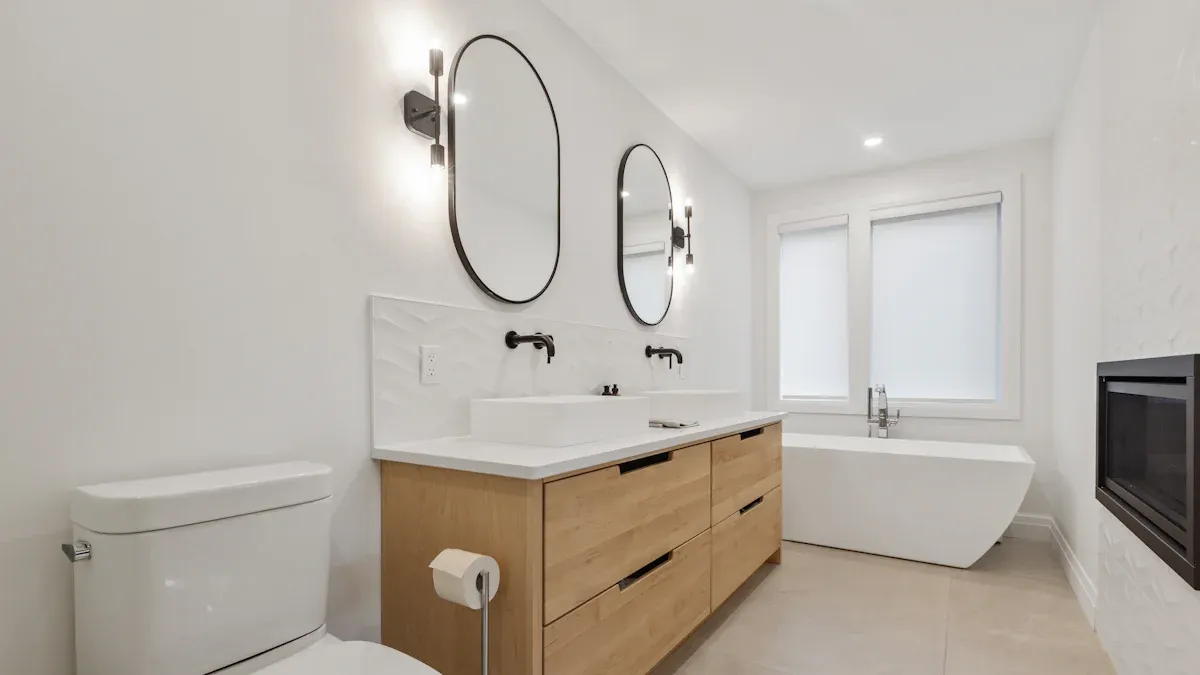
 FEEDBACK
FEEDBACK
If you are interested in our products and want to know more details, please leave a message here, we will reply you as soon as possible.


Ready to tackle your bathroom upgrade? You can master the art of finding studs and mounting a vanity with this Floating Vanity Install Guide. Safety matters when you hang heavy fixtures on drywall. You want your vanity to stay put. Beginners can handle this with simple tools and clear steps. Trust yourself, follow along, and enjoy the process!
You need the right tools before you begin. Getting ready helps you work faster and avoid extra store trips. Most contractors say these tools are best for a floating vanity install:
Floating vanity and mounting hardware
Level
Stud finder
Drill with appropriate bits
Wall anchors (if necessary)
Measuring tape
Pencil
Screwdriver
Wrench or adjustable pliers for plumbing
Silicone caulk
Tip: Keep your tools close by. This saves time and keeps your area neat.
Picking strong materials is important for safety and durability. You want your bathroom to look nice and last a long time. Here are some good choices:
Material Type | Description |
|---|---|
Solid hardwood or plywood | Very strong and can be sealed to resist water. |
Quartz or solid surface countertops | Tough and does not get damaged by water. |
Laminates with PVC edges | Simple to clean and works well in bathrooms. |
Safety is always important when you do home projects. The right gear keeps you safe and makes the job easier. Experts suggest using these items for bathroom work:
Type of Safety Gear | Description |
|---|---|
Protective Clothing | Long sleeves and pants protect you from splinters and chemicals. |
Gloves | Thick gloves help with demo, nitrile gloves help with cleaning. |
Footwear | Boots with slip-resistant soles keep you steady and protect your toes. |
Eye Protection | Safety glasses or goggles stop debris from getting in your eyes. |
Respiratory Protection | Dust masks or respirators help you breathe safely. |
Hearing Protection | Earplugs or protectors keep loud tool sounds from hurting your ears. |
Head Protection | Hard hats keep you safe from things falling when working overhead. |
Knee and Back Support | Knee pads and back belts help when kneeling or lifting heavy things. |
Note: Always check your safety gear before starting. A few minutes can stop injuries and keep your Floating Vanity Install Guide project safe.
You want your floating vanity to stay strong and safe. The best way to do this is by finding the wall studs before you start drilling. This step in the Floating Vanity Install Guide helps you avoid mistakes and keeps your vanity from falling off the wall.
A stud finder makes your job much easier. You just turn it on, place it flat against the wall, and slowly slide it along. The device will beep or light up when it finds a stud. Most homes in North America have wall studs spaced either 16 inches or 24 inches apart from center to center. This spacing gives your wall the strength it needs to hold heavy things like a floating vanity.
Tip: Start from one corner of the wall and move across in a straight line. Mark each stud as you find it. If you lose track, measure 16 or 24 inches from your first mark and check again with the stud finder.
No stud finder? No problem! You can still find studs using a few simple tricks:
Look for electrical outlets or light switches. Builders often attach these to the side of a stud. Remove the cover plate and tap gently on each side. You will hear a solid sound when you tap over a stud.
Knock on the wall. A hollow sound means no stud. A solid sound means you found one.
Use a small finishing nail. Push it into the wall where you think a stud is. If it goes in easily, try again a little to the left or right. When you hit wood, you found the stud.
Note: Always double-check your guess by measuring 16 or 24 inches from a known stud. This helps you stay on track and avoid mistakes.
Once you find the studs, you need to mark them clearly. Use a pencil to draw a vertical line from the floor to just above where the top of your vanity will sit. These marks show you exactly where to drill and attach your mounting hardware.
If you skip this step, you risk big problems:
A floating vanity needs strong wall support to keep it from sagging or falling.
If you miss the studs, your vanity can become crooked or loose over time.
The wall must hold at least 200–300 pounds, depending on your vanity size.